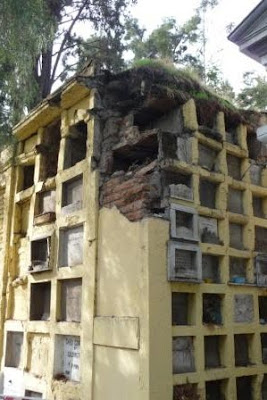¡Hola!
As for school and regular life, not many new updates. Still have class Tuesday through Thursday each week, nice long relaxing weekends that all seem to blend together in the end. I have some big final projects to work on this last month that include writing a 15 page research paper on the income gap in Chile and making a movie about the street performers who literally juggle, eat fire and do acrobatics in the street during red lights, among other papers and tests.
This past weekend I went on a two day excursion to Santiago, the capital of Chile. The first day, IFSA took us on a human rights tour that dealt with the 1973 military golpe or pronuncamiento. The term you use depends on your opinion of the event, golpe meaning 'hit' would describe the military's actions more strongly. For anyone who isn’t familiar with this, the basic situation is that Salvador Allende was the first Socialist president elected democratically in 1970, but due to increasing economic troubles and the communist scare, the military rebelled (with support from the US) in 1973, bombing the presidential palace. This precipitated Allende’s death, most likely a suicide. Pinochet was a strong dictator whose Washington Consensus style free market reforms from the Chicago Boys (Milton Friedman's proteges) created an economic boom in Chile. Yet, he also violently sought out opposition and caused thousands of people to ‘disappear’ during his 16 year term. This period of history is still highly controversial and is generally not discussed in typical conversation. Since it was so recent, most Chileans have personally experienced the consequences of this political turmoil. If anyone is interested, I would highly recommend watching the film ‘Machuca’ as it is a fantastic movie and will help to understand this conflict.
Anyways, the first stop on our tour was watching a video made by the Pinochet Foundation that was in black & white until the glorious day of the military rebellion after which the movie is suddenly in color. Clearly a biased film but nonetheless interesting, it is not available in the US so it was special to see. Our second stop was the General Cemetery of Santiago; this was the most amazing cemetery I have ever seen in my life! It is a beautiful, well-groomed garden filled with elaborate mausoleums and sculptures. All but two of Chile’s presidents are buried in this cemetery, so we were able to see Allende’s mausoleum among many other notable figures. Interestingly Pinochet is one of the presidents who is not buried in this cemetery, he was cremated and there is no gravestone to mark his passing. Another important part of this cemetery is the memorial for all of those who ‘disappeared’ or were politically executed during Pinochet’s regime.
Our final stop on the tour was Villa Grimaldi, a former torture and extermination site during Pinochet’s rule that has been transformed into a memorial and park for peace. Chile only began to openly speak of this dark period of history in 1998, and this park was founded in 2004, so it is a new memorial and a relatively new topic in Chilean history. There is not much left from the years of torture and cruelty as everything was burnt down, but there are a few eerie remains and symbolic representation of what once was there. Our tour guide was extremely knowledgeable about the park and recalled a number of personal accounts from survivors of the torture. I cannot describe the wave of emotions that I experienced in my two hours at the park, intolerance and murder are two things I will never understand.
Moving on with the day, my friends Jacob and Chaz and I decided to leave the tour and spend the night in Santiago. We treated ourselves to a very special dinner in a restaurant called Como Agua para Chocolate and dined on ceviche, fajitas and a fudgy ice cream dessert. It was absolutely delicious and the live guitar and drums added to the pleasant ambiance. We spent the rest of the evening exploring the night life of Bellavista, the happening, young ‘hippie’ area of Santiago.
After a lovely night of sleeping to techno music, we woke up and walked over to Cerro San Cristóbal, an expansive park in the Northern part of the city. After a long and sweaty climb, we reached the statue of the Virgin Mary. From the top we could see a nice view of the city, as well as the very polluted atmosphere.
We trekked back down the hill and wandered through a few different neighborhoods of Santiago. We passed through the huge central market, and walked into the historical district of town. Highlights were the Plaza de las Armas and La Moneda, which is the capital building that was blown up by the military in 1973 to mark the official takedown of Allende’s government, and has since been rebuilt.
It was good to see Santiago, and while it is a nice city, I’m happy I decided to study in Viña instead. Until next time, GO CHILE in the world cup!












